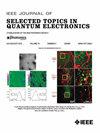Origins and Mitigation of Scattering-Related Propagation Losses in Suspended GaAs Waveguides for Quantum Photonic Integrated Circuits
IF 5.1
2区 工程技术
Q1 ENGINEERING, ELECTRICAL & ELECTRONIC
IEEE Journal of Selected Topics in Quantum Electronics
Pub Date : 2025-06-04
DOI:10.1109/JSTQE.2025.3576388
引用次数: 0
Abstract
Quantum photonic integrated circuits (QPICs) offer a promising path toward scalable quantum technologies. QPICs rely on the integration of many quantum photonic components and interconnecting optical waveguides for generation, manipulation, and detection of single photons. A key challenge in QPICs is the management and minimization of optical losses, which is particularly critical for single-photon applications. In this paper, we investigate optical propagation losses in strip waveguides within suspended gallium arsenide (GaAs) platforms, which can directly host deterministic single-photon sources but suffer high scattering-related losses. We systematically analyze different scattering loss contributions by investigating four key waveguide perturbation types: sidewall roughness, top surface roughness, surface particles, and suspension tethers. Our approach combines rigorous 3D finite-difference time-domain (FDTD) simulations with experimental measurements to decouple and quantify individual contributions to the total propagation loss. We study two suspended GaAs platforms operating at different wavelengths: an established 930 nm platform and an emerging 1300 nm platform in the telecommunication O-band. Based on our findings, we identify the dominant scattering loss mechanisms and propose novel design-time guidelines and concrete strategies to reduce the main loss contributions by factors of 2.5–5. These improvements are crucial for enabling complex QPICs directly within the native platform of the single-photon source, supporting advances in integrated quantum technologies.量子光子集成电路中悬浮砷化镓波导中散射相关传播损耗的来源和缓解
量子光子集成电路(QPICs)为可扩展量子技术提供了一条有前途的道路。QPICs依赖于许多量子光子元件的集成和相互连接的光波导来产生、操纵和检测单个光子。QPICs的一个关键挑战是光损耗的管理和最小化,这对于单光子应用尤其重要。在本文中,我们研究了悬浮砷化镓(GaAs)平台中条形波导中的光传播损耗,该平台可以直接承载确定性单光子源,但遭受高散射相关损耗。我们通过研究四种关键的波导微扰类型:侧壁粗糙度、顶部表面粗糙度、表面颗粒和悬浮系绳,系统地分析了不同的散射损失贡献。我们的方法结合了严格的三维时域有限差分(FDTD)模拟和实验测量,以解耦和量化个人对总传播损耗的贡献。我们研究了两个工作在不同波长的悬浮GaAs平台:一个已建立的930 nm平台和一个新兴的1300 nm电信o波段平台。基于我们的研究结果,我们确定了主要的散射损耗机制,并提出了新的设计时间指南和具体策略,以减少2.5-5因子的主要损耗贡献。这些改进对于直接在单光子源的本地平台内实现复杂的qpic至关重要,支持集成量子技术的进步。
本文章由计算机程序翻译,如有差异,请以英文原文为准。
求助全文
约1分钟内获得全文
求助全文
来源期刊

IEEE Journal of Selected Topics in Quantum Electronics
工程技术-工程:电子与电气
CiteScore
10.60
自引率
2.00%
发文量
212
审稿时长
3 months
期刊介绍:
Papers published in the IEEE Journal of Selected Topics in Quantum Electronics fall within the broad field of science and technology of quantum electronics of a device, subsystem, or system-oriented nature. Each issue is devoted to a specific topic within this broad spectrum. Announcements of the topical areas planned for future issues, along with deadlines for receipt of manuscripts, are published in this Journal and in the IEEE Journal of Quantum Electronics. Generally, the scope of manuscripts appropriate to this Journal is the same as that for the IEEE Journal of Quantum Electronics. Manuscripts are published that report original theoretical and/or experimental research results that advance the scientific and technological base of quantum electronics devices, systems, or applications. The Journal is dedicated toward publishing research results that advance the state of the art or add to the understanding of the generation, amplification, modulation, detection, waveguiding, or propagation characteristics of coherent electromagnetic radiation having sub-millimeter and shorter wavelengths. In order to be suitable for publication in this Journal, the content of manuscripts concerned with subject-related research must have a potential impact on advancing the technological base of quantum electronic devices, systems, and/or applications. Potential authors of subject-related research have the responsibility of pointing out this potential impact. System-oriented manuscripts must be concerned with systems that perform a function previously unavailable or that outperform previously established systems that did not use quantum electronic components or concepts. Tutorial and review papers are by invitation only.
 求助内容:
求助内容: 应助结果提醒方式:
应助结果提醒方式:


